2012 In Review – Volcanoes
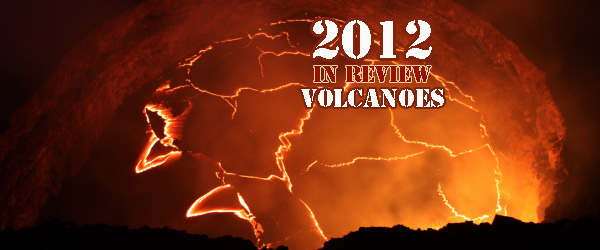
As far as the volcanic activity goes 2012 had lots of interesting moments and Pacific Ring of Fire was focus of almost all of it. 2011 finished with our eyes on the Cleveland volcano, Alaska. Cleveland sent ash 4.5 km in the sky during a single explosion event on Thursday, December 29, 2011.
On January 1, 2012 ongoing volcanic activity was reported at El Hierro (Canary Islands), Fuego (Guatemala), Karymsky, Kizimen and Shiveluch (Kamchatka, Russia), Kilauea (Hawaii), Popocatépetl (México), Puyehue-Cordón Caulle (Chile), Sakura-jima (Kyushu, Japan).
6 Indonesian volcanoes were on high alert at the time – Ijen, Gamalana, Papandayan, Karangetang, Lokon and Krakatau. Ijen turquoise crater lake has changed color to white.
What followed was 12 months of close observations of many volcanoes all around the world. Below is a summary of volcanic events sorted in chronological order for each month of 2012 along with article links for further reading.
January 2012
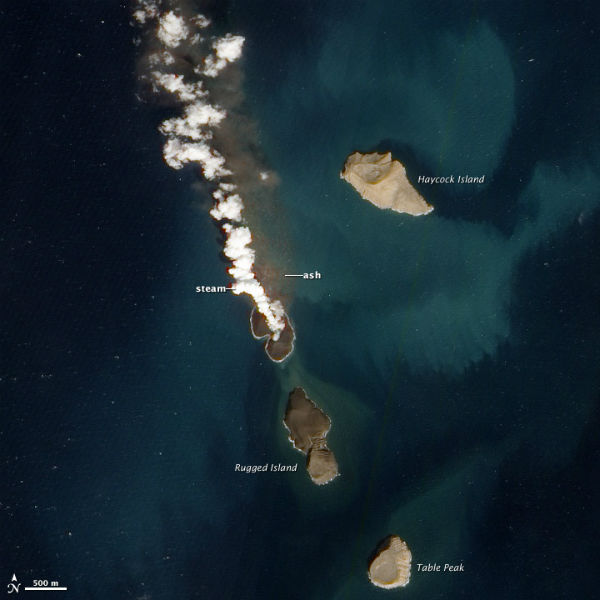 Ash plumes from new volcanic island January 7, 2012 (Source: Advanced Land Imager (ALI) aboard the Earth Observing-1 (EO-1) satellite.)
Ash plumes from new volcanic island January 7, 2012 (Source: Advanced Land Imager (ALI) aboard the Earth Observing-1 (EO-1) satellite.)
January was marked by new island forming in Red Sea as a result of undersea eruption that began in mid-December 2011. Local fishermen reported an eruption near the island of Saba. It was located about 60 km from the coast of Yemen, on the northern edge of the Zubair Islands. Satellites captured a white plume rising from the sea, and a pulse of sulfor dioxide. The eruption near island of Saba had risen nearly completely above water by January 7.
In Italy, Mt. Etna erupted with paroxysmal explosion spewing ash up to 5 kilometers. It is the 19th episode of lava fountains on Mt. Etna, the series that began January 12. The abundant fallout of incandescent volcanic bombs on the northern side of the cone, and at its base, in contact with the snow falling that days, has generated hydromagmatic explosion with the production of lahars and pyroclastic flows.

There was new volcanic activity recorded at Reventador, Sangay and Tungurahua in Ecuador. The emission originated from a Reventador’s growing lava dome was a few tens of meters above the crater rim and almost filled the base. Activity reports also came for nearby Colombian Galeras and Guatemalan Fuego volcanoes. Down North in Chile, Lascar as one of the more active volcanoes of northern Chile, was placed on heightened alert status by the ONEMI. Meanwhile, Cordon-Puyehue Calle continued with ongoing activity.
Ongoing activity continued at El Hierro (Canary Islands), Karymsky, Kizimen and Shiveluch (Kamchatka, Russia), Kilauea (Hawaii), Popocatépetl (México), Sakura-jima(Japan) and Santa María (Guatemala).
In January, 25 Indonesian volcanoes have been reported with an increase of activity. Hundreds of people living near a volcano in the Indonesian province of East Nusa Tenggara were evacuated because of Lewotolo increased its activity. CVGHM raised the Alert Level from 1 to 2 (on a scale of 1-4) on 2 January, then later that day raised the Alert Level to 3.
By January 22, Sakura-jima erupted 142 times. That broke the historical record of September 2011 (141 times).
Mt. Etna enters 2012 with new paroxysmal eruption spewing ash up to 5 kilometers
Increased volcanic activity at Lewotolo volcano, Indonesia
Chile’s Lascar volcano alert status elevated
New island is forming in Red Sea near Zubair Islands
Reventador is waking up – Three volcanoes on alert in Ecuador
Increased activity at 25 volcanoes in Indonesia
Warning about pyroclastic flow from Sakurajima
February 2012
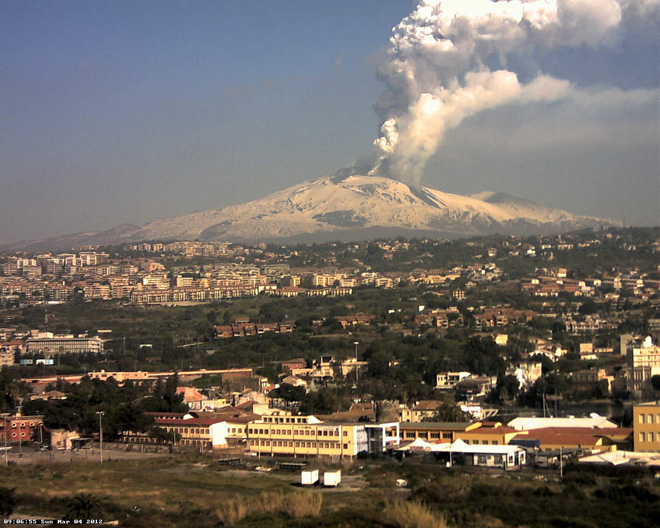

Etna had another strong eruption in early hours of February 9 after more than 12 days of moderate strombolian activity. The eruption was one of the most intense and longest in the series so far.


Kananga at Alaska had awakened after 17 years of quiet time. Alaska Volcano Observatory (AVO) raised the alert status to Yellow/Advisory due the possibility of larger explosive eruptions.
Alaskan Mount Cleveland lava dome grew for 25% (50 meters in size) in February and volcano remained on orange alert status.
New strong eruptions at Mount Etna
Cleveland volcano, Alaska – authorities say sudden eruptions could occur at any time
Mount Cleveland lava dome grows 25%- now 50 meters in size
New activity at Kanaga volcano, Alaska
March 2012
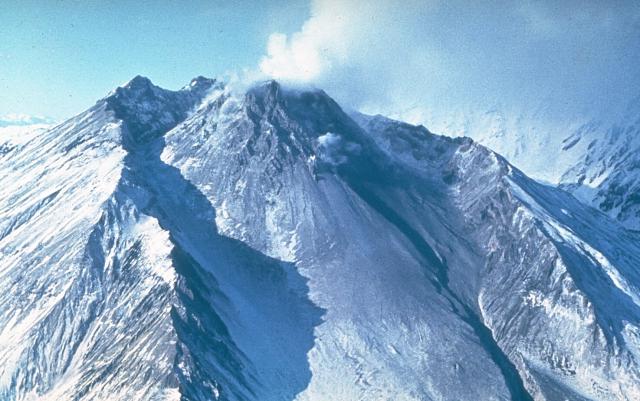

Kamchatkan Bezymianny volcano was placed on red alert early in March.
During March 24 – 25 March Mexico’s Popocatepetl had 33 small steam and gas emissions, accompanied by small earthquakes and volcanic tremor.
Though there were no official reports at the time local community of Popendetta, Papua New Guinea, reported smoke and ash emission from Mt. Lamington on March 25.
Throughout the morning of March 26, a constant column of steam and ash was seen rising from the summit crater of Tungurahua, Ecuador, reaching up to 3 km height and drifting towards the northeast.
Batu Tara volcano in the Sunda Sea off the Island of Flores in Indonesia had a larger than usual ash eruption on March 26. Guatemalan volcanoes Fuego and Santiaguito were on close observation as they both showed increase in activity.
End of March meant close observation of significantly increased activity of Nevado del Ruiz in Columbia.
Etna was active in March also. Strombolian activity continued since March 30, at the new Southeast Crater crater. Explosions threw incandescent material tens of meters beyond the crater edge and, in some cases, bombs fell on the flanks of the cinder cone.
This was all a perfect intro for next couple of months.
Bezymianny volcano in Kamchakta Peninsula on red alert – showing signs of possible eruption
Etna volcano – tremor signal started to rise sharply
April 2012
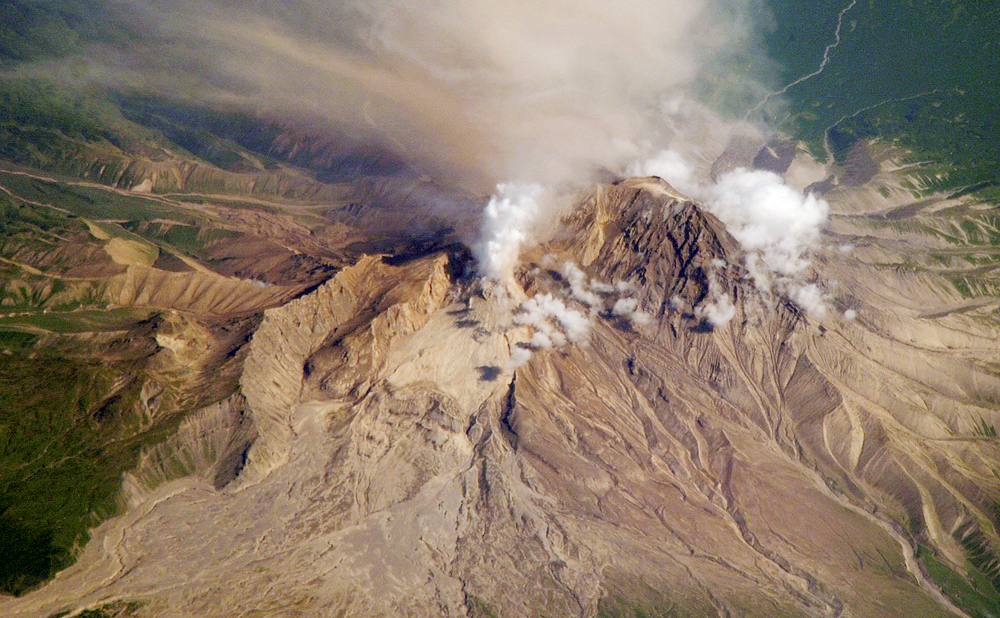

April was the month to watch. There was significant increase of Nevado del Ruiz activity that led to preventive Red alert issued on April 8, for areas downstream the volcano. Authorities said the Turrialbla volcano in Costa Rica had a new wave of eruptions on April 12. Scientists converged on the mountain for a closer look at the smoke spewing from its center.
Popo, as the Popocatepetl, is widely called in Mexico, spewed at least seven exhalations overnight Saturday, April 14, and through the day Sunday, sending vapor, smoke and gas billowing into the clear sky.
Russian Shiveluch, one of the most mentioned volcano names in 2012, churned out ash to a height of 9.5 km, local scientists reported on April 17. Shiveluch stratovolcano increased activity in May 2009 and has been periodically spewing ash from three to ten kilometers.
Santorini, Greece… This volcano deserves special attention as it is the site of one of the largest volcanic events in human history. The Minoan eruption, which occurred around 1650 B.C., buried the major port city of Akrotiri with more than 20 meters of ash and created Santorini’s famous, present-day cliffs. The volcano has been relatively calm since its last eruption in 1950 but its caldera is now awake again and rapidly deforming at levels never seen before. Georgia Tech Associate Professor Andrew Newman has studied Santorini since setting up more than 20 GPS stations on the island in 2006. Santorini story is here.
After several days of increased activity, North Sulawesi’s Mt. Lokon erupted on Tuesday, April 24, the National Disaster Mitigation Agency (BNPB) announced. The height at which lava shot out of the volcano was unknown because clouds were blocking the full view. The agency declared areas within a 2.5 kilometers radius from the mountain’s peak dangerous and urged nearby residents to stay alert.
A new eruption on the remote Zavodovski Island in the South Sandwich island chain was detected by NASA’s Aqua satellite on April 27, 2012. The satellite picture shows a plume originating from the island’s active crater known as Mt. Curry, or sometimes also referred to as Mt Asphyxia. It is possible that the plume was created by lava flows in contact with sea water, as it appears to be mainly steam. Not much else is known about the eruption, because the island is uninhabited and extremely remote and has no monitoring on the island.
On April 29 Nicaraguan experts reported more seismic activity at Masaya volcano with an increase in expulsions of sulfur gases. Disaster warning system was in high alert.
Significant increase in activity of Nevado del Ruiz volcano in Colombia
Areas downstream of Nevado del Ruiz on preventive Red alert
Costa Rica’s Turrialbla volcano unleashed new wave of eruptions
Mexico’s Popocatépetl volcano spewed at least seven exhalations over the weekend
Shiveluch volcano in Russia spews ash to 9,500 meters
The Santorini volcano caldera is awake again and rapidly deforming
Explosive-extrusive-effusive eruption of the Kamchatkan Shiveluch volcano continues
New eruption of North Sulawesi’s Mt. Lokon
New volcano eruption in the South Sandwich Islands at Mt Curry, Zavodovski Island
Nicaraguan experts reported increase in expulsion of sulfur gases from Masaya volcano
May 2012
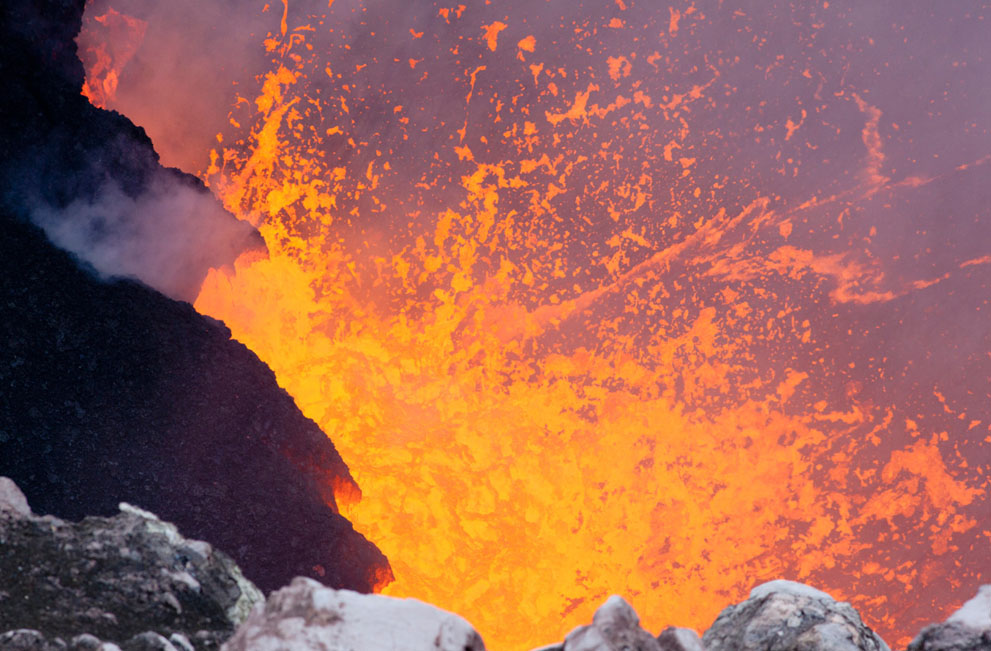

Indonesian Mt. Lokon erupted again on Tuesday, May 1. The eruption was preceded by a number of mild earthquakes over a span of two minutes. National Disaster Mitigation Agency (BNPB) spokesman Sutopo Purwo Nugroho said smoke plumes reached 2,500 meters in height when volcano erupted.
The Sirung stratovolcano on the remote Pantar island in Indonesia has come back to life with a series of probably phreatic explosions and strong degassing. On May 8, 2012 a 3-hour long eruption took place. The eruption was accompanied by loud sounds and incandescent tephra observed rising 10 m above the crater.
Fuego volcano in Guatemala had one of its most explosive and vigorous eruptions in years. The volcano, about 25 miles (40 kilometers) southwest of the capital, erupted on Saturday, May 19, spewing a column of ash up to 5 km above the crater and launching burning red lava nearly 1,300 feet (400 meters) high. The national emergency commission issued an advisory, warning planes not to fly within a 25-mile (40 kilometer) radius of the volcano. Some of the video of the eruption clearly showed large incandescent blocks being thrown from the summit…
Following a series of tremors on May 29, Russia’s Far East Shiveluch volcano spewed ash high into the sky. The column of ash reached up to 7.3 km above sea-level, according to Itar-Tass news agency. No impact or damage has been reported. The outburst came in the wake of a chain of seismic events around the region.
Mount Lokon volcano in North Sulawesi erupted again on May 1, 2012
Sirung volcano back to life and on alert level 3: new phreatic eruption and strong degassing
Lava surges with increased pressure from Kilauea, Hawaii
Fresh blasts from Mexico’s Popocatepetl volcano
New lava flow on Bagana volcano, Papua New Guinea
Fuego volcano in Guatemala had largest eruption in years
June 2012
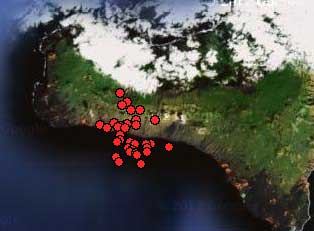

Aside from ongoing activity on Fuego, Shiveluch, Manam and Cleveland June will be remembered by alarming news from Yellowstone National Park.
According to article published in YellowstoneGate a handful of Yellowstone National Park geysers appear to be active again after periods of dormancy, including one geyser that last erupted almost two decades ago. Morning Geyser, quiet for 18 years, is now active, and there is news that an electronic monitor on Echinus in Norris Geyser Basin picked up an eruption. North Goggles Geyser has also started erupting more regularly than the lone annual display it has typically shown over the past few years. The last time it was this active was 2004. Joining the list of newly reactivated thermal features are Fan and Mortar geysers…
El Hierro on Canary Islands was also on close watch this month. There were more than 240 recorded earthquakes on June 26. The situation calmed after a couple of days but the area is still on watch.
Manam – one of PNG’s most active volcanoes has new series of eruptions
Guatemalan stratovolcano Fuego erupted again
Shiveluch volcano on Kamchatka spews ash 8 km high
Cleveland volcano – ash producing explosion sends thin cloud up to 10 km
Yellowstone geysers became active again
July 2012
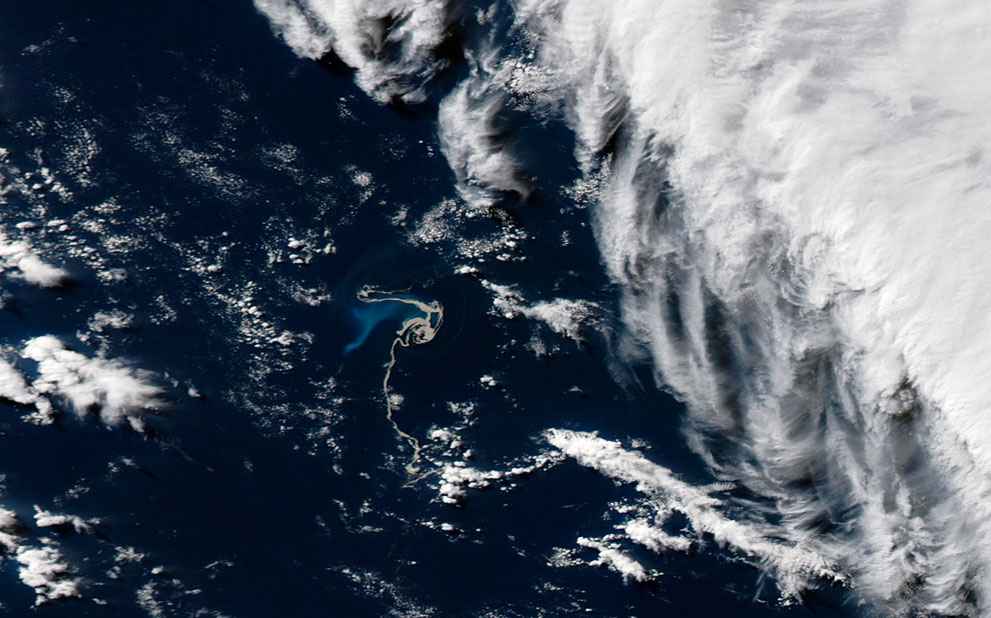

Early July brought news of lava dome collapse at Krakatau volcano, Indonesia. Krakatau exploded spectacularly in a devastating Plinian eruption 1883 that killed more than 30,000 people (mostly by the huge tsunamis triggered by the eruption). The eruption was one of the first global news events after telegraph lines had connected the different continents. Krakatau has been the site of frequent eruptions since 1927.
Kermadec undersea volcano Havre made significant changes to the seafloor during eruption on July 19, 2012.
On July 20 GeoNet raised the Volcano Alert Level at Mt. Tongariro, New Zealand after a series of quakes beneath the volcanic complex.
Sakurajima volcano continued to be particularly active toward the end of month and Popocatepetl had more rumblings and gas emissions.
New hydrothermal vents at Anak Krakatau volcano
Volcano alert level raised for Mt. Tongariro volcano, New Zealand
The new powerful explosions at Sakurajima volcano, Japan
Popocatepetl rumbles again with gas emissions and glowing lava
August 2012
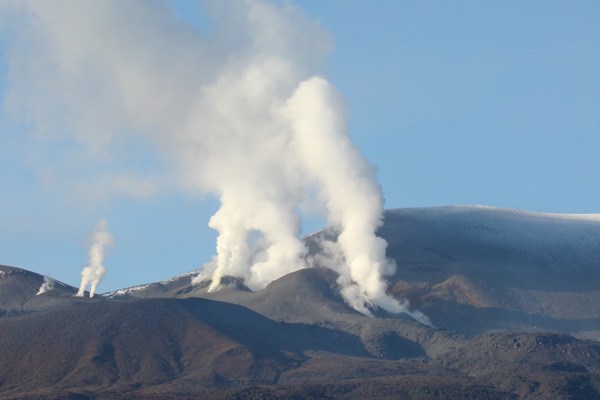

August was New Zealand’s month. A small eruption was reported on August 5 at White Island, New Zealand. This was the first in series of New Zealand’s eruptions. The White Island web camera captured a small eruption on Sunday morning, August 5, 2012 at 04:55 am NZST (August 4, 2012 16:55 UTC) from the Crater Lake at White Island.
New Zealand’s Mt. Tongariro erupted the following day and had bright red rocks flying out of the mountain. GNS science reported that at approximately 11:50 UTC on Monday, August 6, 2012 ash fall began to be reported in the volcano’s vicinity. GNS duty volcanologist Michael Rosenberg told Radio New Zealand that some people are reported to have left their houses on the southern shores of Lake Rotoaira
Increase in seismic activity under Sotarà volcano, Colombia, promted INGEOMINAS to raise the alert level from yellow (unrest) to orange (eruption warning) on August 8, 2012. The increase had been detected on June 24, 2012 and since that date, 6891 earthquakes have been recorded, i.e. an average of 150 quakes per day. Most of them (5177) are of very small magnitude, but the remaining 1714 quakes were of significant energy (local magnitudes 0.1-2.2) and concentrated in an area between 0.1 and 5 km northeast of the volcanic summit at depths between 2 and 6 km.
Volcanic eruption underway on White Island, New Zealand
Bright red rocks flying out of the mountain as second New Zealand volcano erupts – Mt. Tongariro
Sotarà volcano in Colombia on orange alert level, 6900 earthquakes since June 24th
September 2012
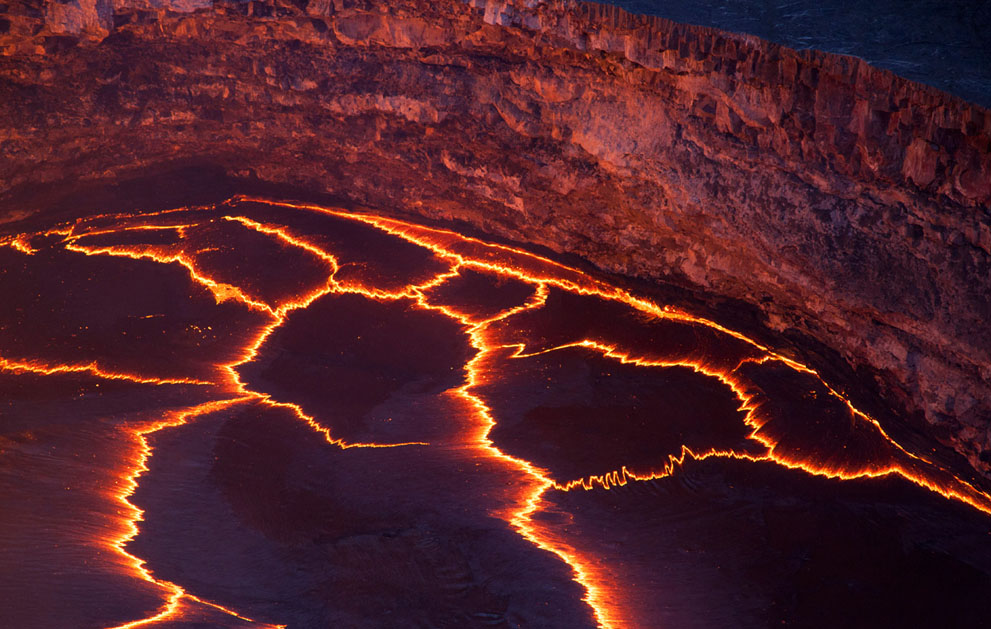

Little Sitkin volcano at Aleutian Islands had swarm of earthquakes that started late August and continued into the September. Bezymianny volcano on Kamchatka had large explosive eruption with ash reported up to 12 km. Indonesian Krakatau had new eruptive phase with powerful explosions. Plume was seen rising from Mount Hodson, South Sandwich Islands.
Volcanic tremors triggered by massive Costa Rican M 7.6 earthquake on September 5, 2012 placed Nicaraguan Apoyeque volcano on green alert. This volcano is located northwest of the Nicaraguan capital Managua and is now being continually monitored for volcanic tremors. Most quakes are located around the Laguna Xiloá, one of the volcano’s active vents. Nicaraguan Institute of Territorial Studies (INETER) registered 21 low-intensity volcano-related tremors between Thursday afternoon and Friday morning (September 6 – 7, 2012), prompting the government to issue a green advisory alert.
San Cristóbal volcano, located 150 km (95 miles) northwest of Managua, erupted on September 8 with three powerful explosions according to Nicaraguan Institute of Territorial Studies (INETER). A column of smoke and ash reached nearly a mile above the cone of the highest volcano in Nicaragua.
More than 33,000 people were forced to evacuate the area after another violent eruption of Guatemalan volcano Fuego. North and northeast winds forecasted for the weekend period would help to steer most of the smoke and ash from the eruption away from the city. Guatemala’s Volcán de Fuego (Volcano of Fire) erupted on the morning of September 13, 2012. According to the Coordinadora Nacional para la Reducción de Desastres (CONRED), the eruption included ash emissions to the west and a 500-meter (2,000-foot) long lava flow. CONRED also warned of pyroclastic flows that could descend the mountain in any direction.
Indonesian stratovolcano Mount Soputan erupted on September 18, 2012 shooting ash and smoke nearly 1500 m (1 mile) into the sky.
Swarm of earthquakes raised alert for dormant Little Sitkin volcano at Aleutian Islands
Large explosive eruption with ash up to 12 km, Bezymianny volcano
Plume seen rising from Mount Hodson, Visokoi Island, South Sandwich Islands
New eruptive phase with powerful explosions, Krakatau volcano, Indonesia
Massive Costa Rican earthquake awakens Nicaraguan Apoyeque volcano
San Cristóbal volcano in Nicaragua erupted – forced evacuation
Eruption of Fuego volcano in Guatemala forced 33,000 people to evacuate
Mount Soputan erupts spewing ash and smoke 1500 m into the sky
October 2012
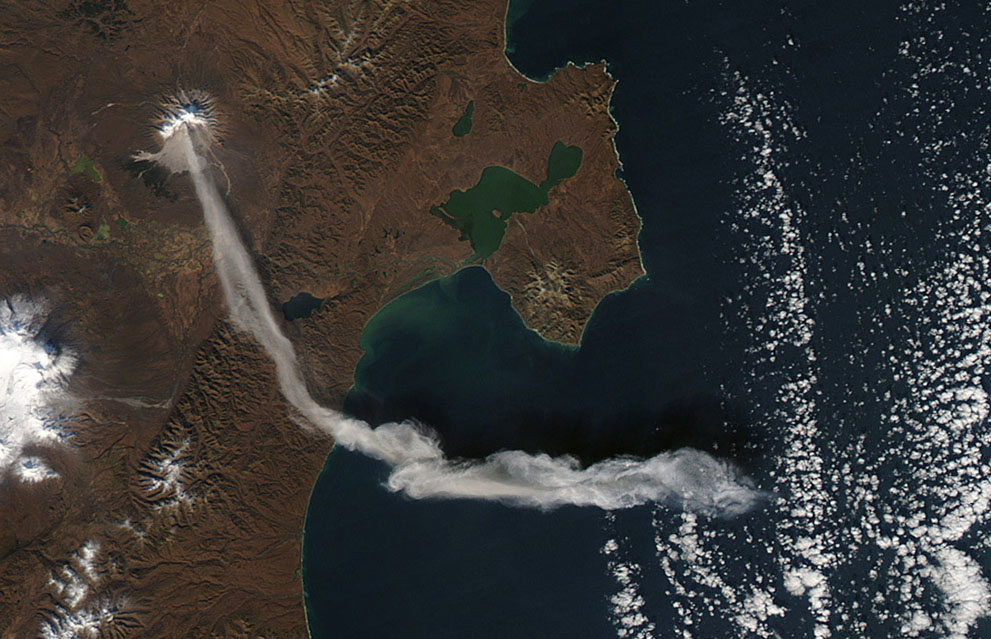

October was relatively calm comparing to earlier months. Mount Lokon volcano in northern Indonesia erupted again on Sunday, October 7, 2012 spewing smoke and ash that caused muddy rain to fall in nearby villages. Local monitoring official Farid Ruskanda Bina told AP that the volcano rumbled as heavy rain fell around its cloud-covered crater. According to Bina the sound was heard 5 kilometers (3 miles) away but the height of the eruption was not visible. The ash made the rain thick and muddy in six villages, Bina said.
New Zealand scientists investigating an active Kermadec undersea volcano Havre discovered significant changes to the seafloor during last eruption on July 19, 2012.
Smoke, ash and muddy rain – New eruption at Mount Lokon, Indonesia
Submarine eruption from Havre volcano built a new volcanic cone
November 2012
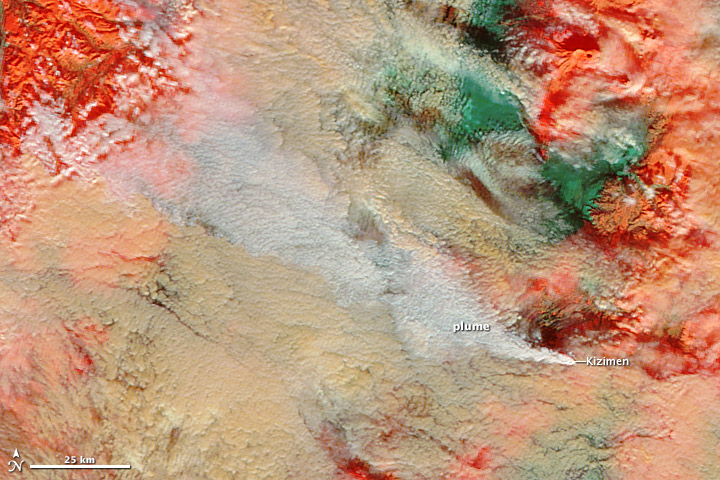

Kizimen volcano, (Kamchatka) which erupted for the first time in 81 years in December 2010, continues to emit gas and ash. The Moderate Resolution Imaging Spectroradiometer (MODIS) on NASA’s Terra satellite captured natural-color and false-color views of the continuing eruption on November 1, 2012. Though the plume is difficult to detect in the true-color image, it shows up clearly in false-color because of the different combination of bands used to create the two images.
Volcanic ash is reportedly spurting out of Mt. Rokatenda (Paluweh), in Sikka regency, Indonesia due to increased volcanic activity since October 1, 2012. Based on analysis of satellite imagery and other data, the Darwin VAAC reported that during 11-13 November ash plumes from Paluweh rose to an altitude of 2.4 km (8,000 ft) and drifted 90-150 km NW and W. People living around the volcano have been evacuated and shelters are provided at Hewuli village. Jakarta post reports that there have been cases of various illnesses, such as respiratory, eye and skin irritation.
Mt. Tongariro, New Zealand, erupted on November 21, 2012 around 1:20 pm local time and lasted for five minutes. Reports say black plume of ash was sent several kilometers up in the sky. Hikers, including schoolchildren were evacuated, residents in the Waikato, Hawke’s Bay, Gisborne and Bay of Plenty areas were advised to stay indoor. Spot of eruption was Te Maari Crater on mountain’s western side. GNS Science duty volcanologist Nico Fournier said, “There was one eruption, essentially one explosion, and it was not sustained. It spewed some ash possibly a couple of kilometres up the air. The ash is now drifting to the east-southeast.”
Tolbachik volcano in Kamchatka, Russia has been showing strong signs of activity by the end of November. The alert was raised from yellow to orange on November 28, 2012. On November 29, 2012 the alert was briefly at red, the highest warning designation, and lowered back to orange. Tokyo VAAC reported that ash plumes from Tolbachik reached heights of 3.5 km.
Kamchatkan Kizimen volcano eruption captured by MODIS
Indonesian volcano Mt. Rokatenda (Paluweh) continues spurting out ash
Mount Tongariro erupts again with black plume of ash
Tolbachik volcano showing sings of strong activity – explosive-effusive eruption underway
December 2012
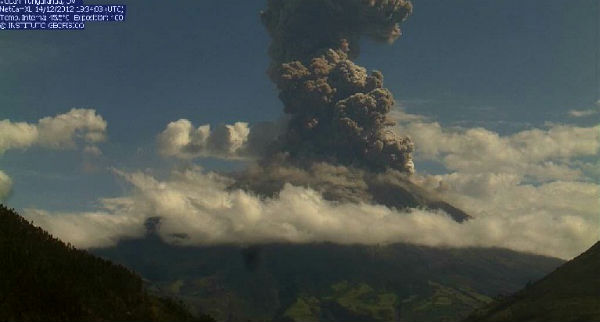

By the end of first half of December new activity was reported at Chirpoi, Kuril Islands (Russia), Karangetang
Ongoing activity was reported for Bagana, Bougainville, Batu Tara, Komba Island (Indonesia), Fuego, Guatemala, Karymsky, Eastern Kamchatka (Russia), Kizimen, Eastern Kamchatka (Russia), Manam, Northeast of New Guinea (SW Pacific), Mayon, Luzon, Paluweh, Lesser Sunda Islands (Indonesia), Popocatépetl, México, Sakura-jima, Kyushu, Santa María, Guatemala, Shiveluch, Central Kamchatka (Russia)
Ecuador has issued the second-highest warning level (Orange) for towns near the Tungurahua volcano. After a huge increase in seismicity on December 15, 2012 a strong ash explosion occurred at 14:35 local time. According to local reports, the eruption produced an ash plume rising to 6 km altitude and was visible from Ambato, Riobamba, Pelileo and Patate.
In a bulletin issued on December 28, 2012 by CONRED, three explosions have been recorded at the Pacaya volcano, Guatemala, with ash seen up to 3 km above sea level. Experts advised that Pacaya’s strombolian type of activity will continue in the coming days or weeks, causing explosions in the crater and possible lava flows in 2013.
Plume rises from Ulawun volcano at Papua New Guinea
New ash explosion with plume reaching 3 km – Lokon volcano, Indonesia
Tungurahua volcano in full eruption – volcanic ash over 7 km
Large ash plume drifting from Copahue volcano, Chile/Argentina
San Cristobal volcano increased activity
Pacaya volcano in Guatemala under close observation – 3 explosions recorded with ash up to 3 km
This report covered only important volcanic activity around the world for the year 2012. Check our Volcanic activity category for list of all volcanic events we have reported during 2012 and 2011.
- Read our 2012 review of solar activity and space weather: 2012 In Review – Solar activity & space weather
Happy New Year!
Top 5 most viewed articles @ The Watchers in 2012:
1. Solar storms and pineal gland – riding the power wave
2. Quake expert Gheorghe Marmureanu: Something is wrong! There are too many strong earthquakes
3. M3.2 solar blast from Sunspot 1402 produced Earth-directed CME
4. Sea of Azov turned bloody red

Commenting rules and guidelines
We value the thoughts and opinions of our readers and welcome healthy discussions on our website. In order to maintain a respectful and positive community, we ask that all commenters follow these rules:
We reserve the right to remove any comments that violate these rules. By commenting on our website, you agree to abide by these guidelines. Thank you for helping to create a positive and welcoming environment for all.